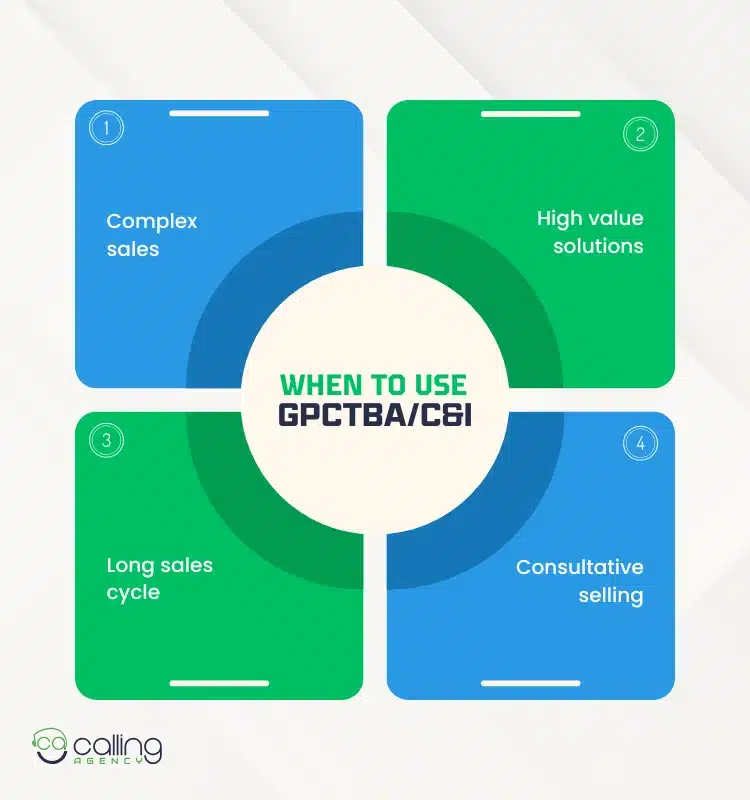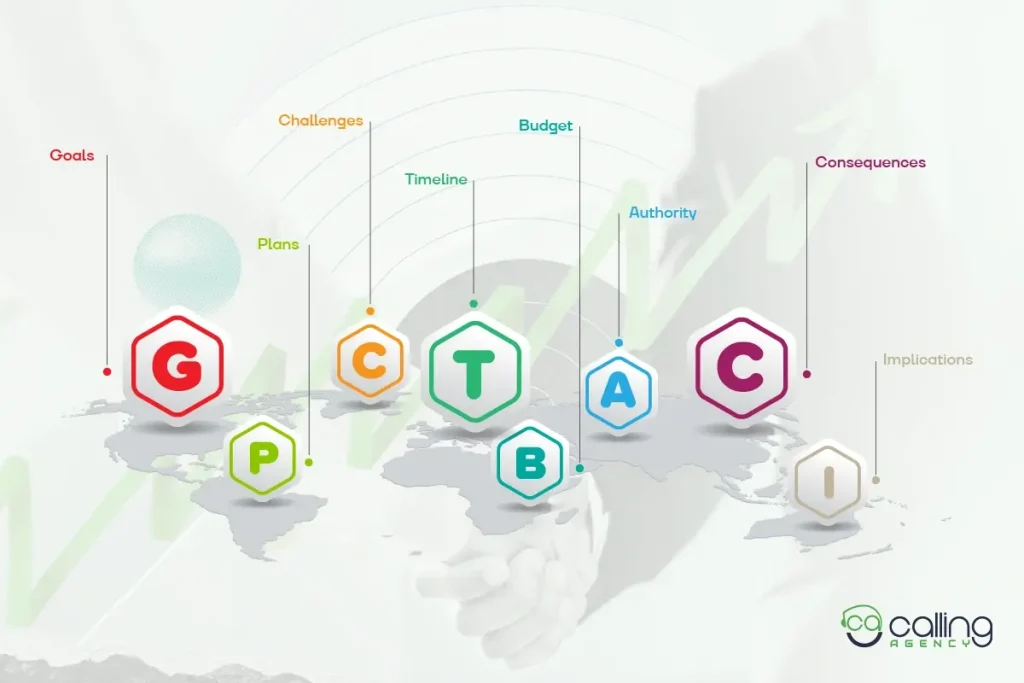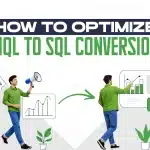GPCTBA/CA is a sales qualification framework that takes the chain of questions deeper to filter out most sales-qualified leads for easy sales. It is an acronym that stands for goals, plans, challenges, timeline, budget, authority, negative consequences, and positive implications. In this web paper, we will walk you through every aspect of GPCTBA/C&I with detailed real-time examples.
History & Origin
GPCTBA/CA is a sales qualification method developed by HUBSPOT in the 2010s for their inbound sales lead qualification. HUBSPOT found that traditional sales lead qualification, like BANT, does not fit with the consultative approach, which is needed for inbound sales leads.
This methodology focuses on building a relationship with potential prospects based on trust and value. GPCTBA/CA is being applied in several industries like software, B2B, service providers, etc, for better ROI and has gained noticeable popularity in a short time.
This framework gained importance by a blog post which was entitled “BANT Isn’t Enough Anymore” by Pete Caputa in 2017, and it represents a significant shift from traditional sales lead qualification to a modern consultative buyer-centric approach.
Components of GPCTBA/C&I
GPCTBA/C&I is an acronym of a few components that represent this methodology of sales lead qualification. Let’s break down every alphabet and how they are aligned with planning and their meaning.
G – Goals
Qualifying sales leads with GPCTBA/C&I you need to follow every step carefully. From the beginning, it starts with G for goal, which represents the clear business objective and expected outcomes of your prospects. Finding your prospect’s vision and aim will provide you with a clear idea about how you approach them and what your offers should be for their problems.
P – Plans
Knowing your prospect’s current strategy and plans is crucial for you. Go as deep as possible into your prospect’s strategy and plan to find their mistakes and improvement areas. Then show them with progressive visuals that they can improve with you for better outcomes with less effort. Pitch your prospects knowing their strategy and showing competitors’ success rules makes your work smoother.
C – Challenges
Identifying your potential prospects’ pain points, obstacles, and challenges is always essential for you. Your prospects’ pain points, highlights, and how they can overcome those obstacles and challenges can be your key to offering them a solution. Your sales team should be responsible for finding your prospects’ difficulties and solutions; if they match, then it can be a hot lead to qualify.
T – Timeline
While qualifying the lead, your sales team needs to find out how quickly the prospects may feel the urgency to buy your service or product, which offers to solve their problems. If your marketing strategy or sales team is able to pitch them to make them feel that they need your service urgently or soon, then this can be a sales-qualified lead. If it’s not in the near future, they need your service, and it’s better to move on with another one.
B – Budget
This is the most important phase to determine whether your prospects have enough budget to go with your service or product. If no, then you can consider this lead as not qualified. So, it is important to probe your prospect to know their financial situation. You can try the following questions for better understanding.
- What is your ideal budget for this type of solution?
- Are there any financial constraints we should be aware of?
- What are your main priorities when purchasing such a product?
- How do you usually assign funds for projects like this?
- What is your timeline for this purchase, and how might it influence your budget planning?
- Who participates in the decision process, and how do they typically handle budget discussions?
- How do you compare our solution to other options you are considering, in terms of price and value?
Those are the key questions for your required information. According to the prospect’s answer, you can design your pitching content effectively.
A – Authority
While probing to know your prospects’ budgets, you can also ask, “Who is responsible for making any purchase for this solution?” and other preferred or customized questions that meet your requirements to get enough information. If you can find and it seems the responsible person is reachable, then your lead can be considered sales qualified.
C – (Negative) Consequences
While making conversation with your prospect, you can highlight if they do not take the solution sooner, what can be the result for their ROI and annual revenue. Creating scarcity of your service to their business is essential. What might happen if they take your service, and if it does not bring any benefit?. These kinds of consequences can happen; this is the fear that can roam inside your prospect’s head. So, to make those things clear, how your solutions can impact their business.
I – (Positive) Implications
What are the positive things that might happen when taking your service? Letting your prospect know those answers with a positive vibe is essential to encourage them to make a purchase. Positive implication is always important if your is not sales qualified; even so, they can refer you to other businesses if you have a positive impact on them.
The above components represent GPCTBA/C&I methods for qualifying sales leads, and applying this framework not only helps the sales team but also the lead generation team with inspiring better outcomes.
Benefits of using GPCTBA/C&I
There are a lot of benefits of using GPCTBA/C&I in your sales funnel. Once you habituate these methods, your sales team’s efficiency will be increased with less effort than before. This process weeds out all shitty leads and give your team a clean hot leads which are sales qualified (SQL). Let’s take a look at the direct benefits of running this framework in your sales funnel.
- Enhanced Understanding of Prospects
- Efficient Lead Qualification
- Customer-Centric Selling
- Effective Resource Allocation
- Stronger Value Proposition
- Improved Sales & Marketing Alignment
- Stronger Relationships with Prospects
- Increased Conversion & Win Rates
- Comprehensive Framework for Evaluation
- Prioritization of High-Quality Leads
Those are the benefits you will directly get from the GPCTBA/C&I method if you implement it appropriately, but keep in mind if this method fits with your business.
Disadvantages of using the GPCTBA/C&I Framework
“There is no rose without a thorn.” This quote reminds us that every process or thing that has good sides may also have some bad sides. Like all other frameworks, G PCTBA/C&I also has some drawbacks, such as:
Complexity and training: This framework is one of the most complex methods among other frameworks, such as:
Etc., these are the most used and popular frameworks. Among all of the above methods, GPCTBA/C&I needs more training for your sales personnel and marketing team to get used to it.
Time-intensive process: Adapting this framework in your sales funnel can be time-consuming and requires extra manpower to implement because of its lengthy process.
So, if you already have a smooth sales cycle and better results, then maybe you don’t need to enforce this framework into your business. For a business that has a large number of leads, it may not be a good fit as well. So first, you need to identify whether this method fits your business or not, then go with it.
GPCTBA/C&I in Action: Real-World Example
Company: Mid-sized E-commerce Retailer
Product: Inventory Management SaaS
Sales Rep: Alex
G – Goals
- Alex: What’s your main business goal for the next two quarters?
- Prospect: We want to reduce stockouts and overstock issues by 40%
P – Plans
- Alex: What plans do you have in place to achieve this goal?
- Prospect: We are manually forecasting demand and plan to hire two inventory planners.
C – Challenges
- Alex: What challenges are you facing with your current approach?
- Prospect: It is time-consuming, error-prone, and we still miss demand spikes.
T – Timeline
- Alex: When are you planning to implement a new solution?
- Prospect: We would like to have something live within 3 months.
B – Budget
- Alex: Have you allocated a budget for this project?
- Prospect: Yes, around \$15,000 annually.
A – Authority
- Alex: Who else is involved in the decision-making process?
- Prospect: I will make the recommendation, but my CTO signs off on the tech.
C\&I – Consequences & Implications
- Alex: What happens if the current problems persist?
- Prospect: We will keep losing sales during high-demand periods and may delay expansion.
Result: Alex shapes his demo to show how the software uses predictive analytics to automate prediction, helping meet the prospect’s goal in budget and timeline, closing the deal.
When to Use GPCTBA/C&I
When to use GPCTBA/C&I is mandatory to start the game of sales lead qualification because misstiming can cause you to lose time and labor. So let’s discuss key points of when to use this framework for the best possible result.

Complex sales: when your sales team needs a deep understanding of prospects’ needs, which are mostly complex and hard to crack.
High value solutions: When your prospect is going to invest a big number into your service, then your salespeople need to be aware of every single problem and possibilities, and here comes this method.
Long sales cycle: when multiple decision makers are involved in this sales process and it continues for months, then GPCTBA/C&I can be very beneficial.
Consultative selling: if your prospects need counselling to convince, then you are investing a lot of time in them, so you need to be sure about many more things to make it work.
The above points are the main indicators when to use, but if you feel like this method can really help you in different situations, you can implement it for better results in sales.
Best Practices for Implementing GPCTBA/C&I
Implementing in a messed way can be “good turning into evil”, so you need to be careful with a few things like:
- Train Your Sales Team
- Use a Structured Approach
- Foster Collaboration
- Monitor and Evaluate Performance
- Adapt to Changing Needs
The above key points are essential to follow while you are set to implement the GPCTBA/C&I methods into your business.
Conclusion
To sum up, as a sales lead qualification framework, GPCTBA/C&I is a modern, appropriate, and guaranteed successful result-giver (if implemented properly) methodology. Even so, you are not sure whether to use any framework and are struggling with high-quality leads, you can book a session with CallingAgency for consultation, because CallingAgency has a proven track record in providing lead generation services.





